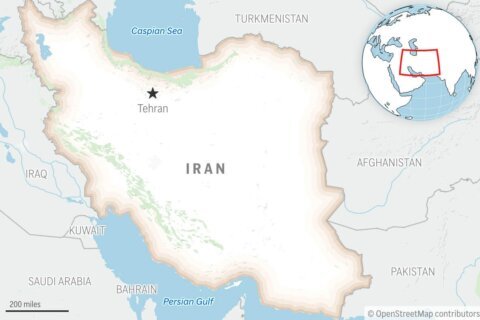Countries That Accept the Most Migrants
The European Commission pledged $40 million on July 4 to help Italy manage the surge of migrants arriving from Africa. Since the beginning of 2017, more than 100,000 migrants have made the perilous journey across the Mediterranean Sea to seek refuge in Europe, with Italy initially receiving about 85 percent of migrants, according to the United Nations.
As thousands fleeing unrest in the Middle East and North Africa travel to the European Union, member nations have hesitated to create a quota system that would require each country to resettle a specified amount of people. Italy, struggling with the costs and logistics of housing thousands of refugees, has criticized other EU nations for refusing to shoulder their share of migrants and relieve some of its burden.
According to data from the Organization for Economic Cooperation and Development, the number of new asylum-seekers reached a record of about 1.6 million in 2015, with approximately 22 percent of refugees coming from Syria, by far the leading country of origin. Here is a look at the 10 countries in the 35-member organization that took in the most permanent residents — which includes foreign nationals moving to the country as well as those already there on a permanent basis. The most recent data, coming from 2015 and during the height of the refugee crisis, offers a portrait of global conditions as countries scrambled to handle the flood of migrants.
UPDATE: An earlier version of this list was published Sept. 25, 2015.
10. Switzerland
Switzerland accepted 131,200 permanent immigrants in 2015. By the end of 2016, nearly 2 million foreigners were permanently living in Switzerland — about a quarter of the country’s population. Immigrants from EU or European Free Trade Association countries made up nearly 70 percent of the total, with Germans and Italians being the largest groups.
There were 27,200 applications for asylum in 2016, down about 31 percent from 2015 after authorities closed the Balkan land route taken by thousands fleeing war-torn countries in the Middle East, Asia and Africa. Other countries have also sealed off their routes in the past year. Just under half of applicants were granted either asylum or provisional admission in 2016, with the three main countries of origin being Eritrea, Afghanistan and Syria.
9. The Netherlands
The Netherland accepted 146,800 permanent immigrants in 2015. Countries sending the most immigrants to the Netherlands were Poland, Germany, the U.K., Italy, Bulgaria, Romania and Spain.
Requests for asylum rose dramatically between 2014 and 2015, from 24,500 to 45,000. About 43 percent — 8,700 — of asylum-seekers came from Syria in 2015, the rest from Eritrea, Iraq, Afghanistan and Iran. The number of asylum requests from unaccompanied minors quadrupled to 3,900 in 2015.
In the 2017 election, Dutch Prime Minister Mark Rutte soundly defeated the populist Geert Wilders, known for his anti-immigration and anti-Islam platform. Still, a Dutch court ruled in June that the government can’t be legally compelled to take in more migrants, as dictated by the 2015 EU agreement.
8. Italy
Italy accepted 160,900 permanent immigrants in 2015, bringing the total number of foreign nationals living in Italy to about 5 million. A third were born in the EU, while the majority of non-EU nationals came from Romania, Albania, Morocco, China and Ukraine. After family reunification, humanitarian protection accounted for the greatest share of new permits granted, at 28 percent.
A frontline state for arriving refugees, Italy is struggling to care for refugees rescued in the Mediterranean and brought to its shores. There were more than 120,000 asylum applications in 2016, an increase of 47 percent since 2015. The country recognized 38 percent of applicants as refugees or granted them subsidiary or humanitarian protection.
7. Spain
Spain accepted 194,900 permanent immigrants in 2015. Immigration to Spain increased 10 percent in 2015, and emigration from the country declined 20 percent in the first year of positive net migration in Spain since the onset of the global financial crisis. Still, emigration of Spaniards reached more than 99,000 in 2015. Of the 290,000 foreign nationals who entered Spain in 2015 — permanent immigrants as well as an additional 100,000 passing through — 10 percent were Romanian and nearly 8 percent Moroccan.
International protection applications reached 14,800 in 2015, a record figure that continued to climb in 2016 to 16,500. To handle the influx, the country has strengthened its asylum and reception system by increasing funding and facilities and reforming its system for handling unaccompanied foreign minors.
6. Australia
Australia accepted 226,200 permanent immigrants in 2015. Permanent migration increased marginally during the country’s 2015 to 2016 immigration program, primarily driven by a 28 percent increase in the country’s humanitarian intake. For the fifth consecutive year, most immigrants came from India, followed by China and the U.K.
During the country’s 2015 to 2016 Humanitarian Program, Australia granted 17,555 visas, primarily to asylum-seekers and refugees from Iraq, Syria, Myanmar, Afghanistan and the Democratic Republic of the Congo. More than 15,500 of these visas were granted under the offshore resettlement program; Australia’s controversial refugee policy involves paying small island states Nauru and Papua New Guinea to house migrants in conditions condemned by human rights groups.
Australia refuses to settle asylum-seekers who attempt to arrive by boat. Last year, in a deal struck by former President Barack Obama, Australia announced it would accept an unspecified number of refugees from a U.S.-led program in Costa Rica, and the U.S. said it would take up to 1,250 refugees rejected by Australia for trying to arrive by boat. U.S. President Donald Trump initially called the plan “dumb,” but U.S. officials later said the arrangement will be honored.
5. France
France received 256,500 permanent immigrants in 2015. The country granted 217,500 new residence permits to non-EU nationals. A third were North African, and more than a fifth sub-Saharan African. Though just 20,500 new residence permits were issued for work reasons, labor migration increased 8 percent in 2015.
The 2017 presidential election pitted the anti-immigration, anti-EU. Marine Le Pen against the progressive Emmanuel Macron in a race that resembled the recent elections in the U.S. and the U.K. In the end, Macron’s pro-immigration party won out, though his stance on the importance of refugee aid has been less firm. France received about 75,000 applications for asylum in 2015, up nearly 26 percent from the previous year. The trend continued in 2016, reaching 78,000 applicants — the most in French history. Most applications came from Sudan, Afghanistan and Haiti. France accepted 29 percent of the 70,000 applications it considered in 2016, compared with the EU’s 62 percent.
4. Canada
Canada accepted 271,800 permanent immigrants in 2015, more than any year since 2010. More than 170,000 were admitted under the economic category, including skilled workers and caregivers.
Refugees made up the the largest increase in permanent migration in 2016; the 58,000 admissions nearly doubled the number of refugees entering the country in 2015. Canada resettled more than 40,000 Syrian refugees between November 2015 and January 2017. The influx has put a strain on authorities, though Prime Minister Justin Trudeau insists refugees will remain welcome in Canada.
3. The United Kingdom
The U.K. took 378,800 permanent immigrants in 2015, and with fewer citizens emigrating from the country, the U.K. had a record year for net migration. Most immigrants were from EU countries, followed by Bulgarians. For the first time, Romanians accounted for 10 percent of the U.K.’s foreign-born population. The major U.K. policy issue in 2016 was the vote to leave the EU — a decision known as Brexit — in which concerns over immigration played a key role.
Despite more net migration, 12.7 percent fewer settlement grants were given in 2015 than in 2014, and in 2016 the figure dropped a further 35 percent to 59,000 grants, primarily due to fewer work, family and asylum-related grants. In 2016, 30,600 people filed for asylum in the U.K., the first year of falling asylum applications since 2010. The U.K. has been somewhat insulated from the migrant crisis enveloping Europe because it is separated from the rest of Europe’s land mass by the English Channel.
2. Germany
In 2015, Germany accepted 686,000 permanent immigrants, 82,400 of whom came to Germany for family reunification. A 30 percent jump from 2014, most immigrants who came to reunite with their families came from Syria, Turkey and Russia. Net migration nearly doubled in Germany in 2015, largely due to the high number of people seeking asylum there, and decreased considerably the following year.
In 2016, there were 722,000 first-time asylum applications — compared with 442,000 in 2015 — and applicants came mainly from Syria, Afghanistan and Iraq. That accounts for about 44 percent of all asylum applications in the OECD’s 35 countries. Approximately 59 percent of the 696,000 processed applications were granted either refugee status or subsidiary protection in 2016.
Many migrants currently traveling to and through Europe hope to reach Germany because of its wealth and job opportunities. Germany has tried to make it easier for asylum-seekers to enter the workforce as its native population ages, with the lowest unemployment rate since reunification in 1990.
1. The United States
The U.S. accepted 1,051,000 permanent migrants in 2015, remaining the top country for immigration. This number measures lawful permanent resident status granted and does not include migration to the U.S. by other means. These new immigrants brought the entire U.S. foreign-born population to 13.3 percent of the total population.
The U.S. is also the top refugee resettlement country, with most refugees coming from Myanmar, Iraq, Somalia, the Democratic Republic of Congo and Bhutan. In 2015, the U.S. admitted 69,920 refugees, unchanged from the previous year. President Donald Trump has issued a number of executive orders affecting immigration policy in recent months, including orders aimed at strengthening border security and immigration law enforcement, and improving screenings of those seeking admission to the U.S.
Want to Know More?
Want to know more about immigrants, refugees and other issues of pressing international concern?
Visit Best Countries or join us on LinkedIn, where you can read about the latest global trends.
More from U.S. News
Report: Fewer Immigrants Living in the U.S. Illegally
Luckily for Trump, Immigration Isn’t Going Away
The Top 10 Fattest Countries in Europe
10 Countries That Take the Most Immigrants originally appeared on usnews.com







